Photo: Trillium grandiflorum, Joseph Erlewein
Trilliums are a spring ephemeral (ephemeral means the part of the plant above the ground will die off by summer and disappear) wildflowers that grace the woodlands of North America and Eastern Asia. Depending on whose taxonomy you follow there are between 40 – 45 trillium species worldwide. I follow the taxonomy of BONAP (Biota of North America Program) that says there are 40 species native to North America. The largest concentration of trillium species is in the southeastern United States with 26 species. The Mid-Atlantic Region contains 16 species. In the next few blog posts I will be giving a complete identification treatment for all the trillium found in the Mid Atlantic Region.
As I mentioned above, the taxonomy of the genus Trillium is in a state of flux. Most botany texts say that trilliums belong to the Lily Family, Liliaceae. The genus has been included in other families like Trilliaceae or Melanthiaceae. Below is the classification for the genus according to the USDA (United States Department of Agriculture):
Kingdom – Plantae (Plants)
Subkingdom – Tracheobionta (Vascular Plants)
Superdivision – Spermatophyta (Seed Plants)
Division – Magnoliophyta (Flowering Plants)
Class – Liliopsida – (Monocotyledons)
Subclass – Liliidae
Order – Liliales
Family – Lilaceae (Lily Family)
Genus – Trillium
The United States Forest Service gives a great description of trillium physiology,
“Trillium plants produce no true leaves or stems above ground. The “stem” is actually just an extension of the horizontal rhizome [an underground stem]and produces small, scale-like leaves called cataphylls [a leaf whose primary function is something other than photosynthesis]. These highly modified leaves surround the flowering scape (the above ground plant) as it pushes up through soil in early spring. The leaf-like structures are technically bracts underneath the flower. Despite their morphological origins, the bracts have external and internal structure similar to that of a leaf, function in photosynthesis, and most authors refer to them as leaves.
Unfortunately, to identify a few trillium species we’ll have to get technical with the botanical terms. I will always try to explain the unusual terminology and I’m even going to debut my artistic skills (said tongue in cheek) to the public with drawings that will help any reader who is not familiar with botanical terms.
Trilliums are typically divided into two groups: The sessile flowering trilliums and the pedicellate trilliums. The sessile trilliums have flowers that lack pedicels. A pedicel is the part of the flower that acts like a stem that attaches the flower to the main stem or a branch of a plant. Because sessile trillium flowers lack a pedicel, the flower sits erect on top of the leaves. Pedicellate trilliums have flowers with pedicels. Because the flowers have pedicels they often hang to the side of the plant or even underneath the leaves. Below are two photos showing a sessile style trillium and a pedicellate trillium.
Photo: Toadshade (sessile type trillium), Jim Pater
Catesby's Trillium (pedicellate type trillium), Rskoon
Trilliums are usually found in mature forests without a heavy understory. River plains, moist coves, and rocky bluffs are other habitats where trilliums can be found. Many species require certain soil types with lots of lime or calcium. Certain types of trillium often grow clumped together forming dense carpets of plants like the photo below of a carpet of Trillium grandiflorum. Trilliums are pollinated by ants, gnats, beetles, and other insects. Many species have a fetid oder of rotten meat that draws bugs to the plant to help spread pollen.
Many trillium species are very rare and of the 16 species found in the Mid Atlantic region many are state threatened or endangered. Below is a list of endangered and threatened trillium species by state.
New York -- Trillium sessile (Toadshade), endangered
Trillium cernuum (Nodding Trillium), exploitably vulnerable
Trillium erectum (Red Trillium), exploitably vulnerable
Trillium grandiflorum (White Trillium), exploitably vulnerable
Trillium undulatum (Painted Trillium), exploitably vulnerable
Pennsylvania -- Trillium nivale (Snow Trillium), state rare
Maryland -- Trillium flexipes (Nodding Wakerobin), endangered
Trillium nivale (Snow Trillium), endangered
Trillium pusillum (Dwarf Trillium), threatened
North Carolina -- Trillium discolor (Pale Yellow Trillium), threatened
Trillium pusillum (Dwarf Trillium), endangered
Loss of habitat is the leading cause of trillium disappearance. Another problem for trillium and many other native plants is the explosion in the White-tailed Deer population. Deer love to eat trillium and there have been studies that prove that over grazing by White-tailed Deer have seriously endangered certain stands of trillium and wiped out entire populations. Another problem is human harvesting. We need to leave these flowers alone and enjoy them in their natural surroundings. Trilliums can be beautiful in a garden setting. Getting seed or plant stock from a reputable dealer who breeds cultivated plants is always preferable than trying to transplant wild stock into your garden.
Identification of trillium species can sometimes be difficult. Certain species readily hybridize with other species creating hybrids that can baffle even the experts. Below is a photo of Trillium simile and Trillium vaseyi and what happens when the two species hybridize.
Many times getting a plant to species level is just impossible because certain plants don't play by the rules. Plants that are typically red can have white forms. Plants whose flowers typically droop can have their flowers standing erect. That said, I am going to give as precise as possible information on how to identify all 16 species of Trillium from the Mid Atlantic region. The treatment will be in four sections based on plant structure and color. I hope to inspire everyone to get out in the woods and cultivate a relationship with our native species.
Thanks to all the photographers who made this post possible
Joseph Erlewein -- http://www.flickr.com/photos/jre/
Jim Pater -- http://www.flickr.com/photos/paterjt/
Rskoon -- http://www.flickr.com/photos/68137880@N00/
David DeHoey -- http://www.flickr.com/photos/daviddehoey/
Dogtooth77 -- http://www.flickr.com/photos/53817483@N00/
Jason Hollinger -- http://www.flickr.com/photos/7147684@N03/
Photo: (from the left) Trillium simile, hybrid Trillium simile x vaseyi, Trillium vaseyi, Jason Hollinger
Many times getting a plant to species level is just impossible because certain plants don't play by the rules. Plants that are typically red can have white forms. Plants whose flowers typically droop can have their flowers standing erect. That said, I am going to give as precise as possible information on how to identify all 16 species of Trillium from the Mid Atlantic region. The treatment will be in four sections based on plant structure and color. I hope to inspire everyone to get out in the woods and cultivate a relationship with our native species.
Thanks to all the photographers who made this post possible
Joseph Erlewein -- http://www.flickr.com/photos/jre/
Jim Pater -- http://www.flickr.com/photos/paterjt/
Rskoon -- http://www.flickr.com/photos/68137880@N00/
David DeHoey -- http://www.flickr.com/photos/daviddehoey/
Dogtooth77 -- http://www.flickr.com/photos/53817483@N00/
Jason Hollinger -- http://www.flickr.com/photos/7147684@N03/


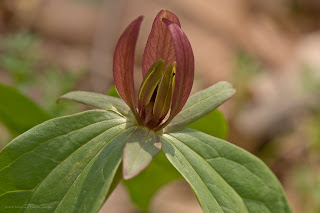
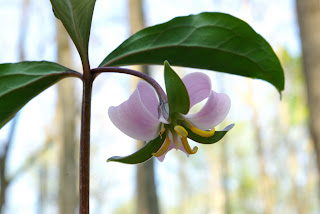
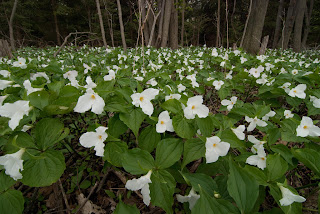
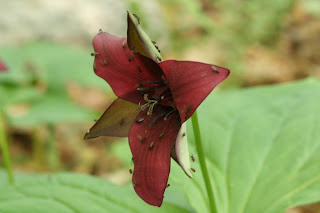
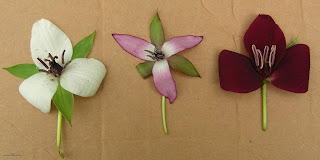
No comments:
Post a Comment